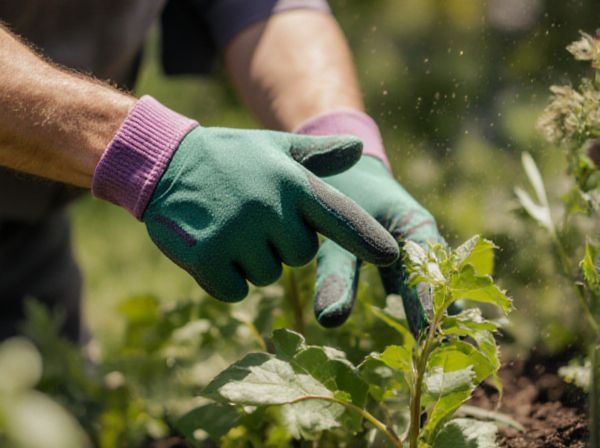
Rake vs Scarifier Illustration
A rake is designed primarily to gather leaves, grass, and debris, making it ideal for surface-level yard maintenance. In contrast, a scarifier removes thatch and moss by cutting through the soil, promoting healthier lawn growth. Choosing between a rake and a scarifier depends on whether you need simple debris removal or deeper lawn aeration and rejuvenation.
Table of Comparison
| Feature | Rake | Scarifier |
|---|---|---|
| Purpose | Loosens soil and removes debris | Cuts into soil for aeration and thatch removal |
| Soil Impact | Superficial surface-level disturbance | Deeper soil penetration and aeration |
| Common Use | Leaf and debris collection, soil leveling | That removal, lawn preparation, soil scarification |
| Operation | Manual or powered, uses tines or teeth | Powered machines with rotating blades or tines |
| Best For | Light garden cleanup and surface maintenance | Improving soil health and lawn rejuvenation |
| Effect on Grass | Minimal stress or damage | May cause temporary grass stress or damage |
Introduction: Understanding Rake and Scarifier
Rakes are garden tools designed to collect leaves, grass, and debris by using a set of flexible or rigid tines to gather surface materials efficiently. Scarifiers, also known as lawn dethatchers, feature sharp blades that penetrate the soil surface to remove thatch, moss, and compacted layers, promoting better air and nutrient flow for grass roots. Understanding the distinct functions and designs of rakes versus scarifiers helps in selecting the right tool for lawn maintenance and soil health enhancement.
What is a Garden Rake?
A garden rake is a versatile landscaping tool designed with sturdy metal tines to gather leaves, grass clippings, and debris efficiently. Its wide head and rigid structure make it ideal for leveling soil and breaking up hardened ground in garden beds. Unlike scarifiers, which are specialized for removing thatch and aerating lawns, garden rakes primarily facilitate surface clearing and soil preparation.
What is a Lawn Scarifier?
A lawn scarifier is a specialized garden tool designed to remove thatch, moss, and dead grass from the soil surface, improving air, water, and nutrient penetration to grassroots. Unlike a rake, which only collects debris from the surface, a scarifier uses blades or tines to penetrate and lift compacted material, promoting healthier lawn growth and preventing lawn diseases. Regular use of a lawn scarifier enhances soil aeration and encourages the development of a dense, vibrant turf.
Rake vs Scarifier: Key Differences
A rake is a hand tool with rigid tines used primarily for gathering leaves, grass, and debris, while a scarifier has metal blades designed to cut through soil or thatch, promoting lawn aeration and healthy grass growth. Rakes are ideal for surface-level maintenance, whereas scarifiers penetrate the turf to remove dead material and improve nutrient absorption. Choosing between a rake and scarifier depends on the specific lawn care task, with rakes suited for debris clearing and scarifiers for soil rejuvenation.
When to Use a Rake in Gardening
A rake is ideal for collecting leaves, grass clippings, and light debris on garden beds and lawns, promoting a clean and tidy appearance. It is best used during early spring or fall to remove surface debris and thatch without disturbing soil structure or plant roots. Unlike scarifiers, which penetrate deeper to aerate and remove dense thatch, rakes provide gentle maintenance suitable for routine garden care.
When to Use a Scarifier for Your Lawn
A scarifier is essential for lawns suffering from heavy thatch buildup and compacted soil, as it effectively removes dead grass and aerates the ground to promote healthier growth. Use a scarifier in early spring or fall to prepare the lawn for new grass seed and improve nutrient absorption. Choosing a scarifier over a rake helps prevent soil damage and ensures deeper penetration for long-term lawn health.
Pros and Cons: Rake vs Scarifier
A rake offers versatility for gathering leaves, grass clippings, and debris, making it ideal for light surface cleaning; however, it lacks the depth to remove thatch or aerate soil effectively. A scarifier excels at dethatching and promoting lawn health by removing compacted debris and thatch buildup but requires more effort and can damage the grass if used improperly. Choosing between a rake and a scarifier depends on lawn care needs: surface debris removal favors a rake, while deep lawn maintenance calls for a scarifier.
Effect on Lawn Health: Rake or Scarifier?
Scarifiers penetrate deeper into the soil, removing thatch and moss to enhance aeration and promote stronger grass root growth, significantly improving lawn health. Rakes primarily loosen surface debris and light thatch without disturbing the soil structure, providing a gentler option for regular maintenance. Choosing a scarifier benefits lawns with heavy compaction or dense thatch layers by facilitating better nutrient absorption and water infiltration.
Choosing the Right Tool for Your Garden Needs
Rakes are ideal for gathering leaves and loosening surface debris, making them perfect for general garden cleanup. Scarifiers penetrate deeper, removing thatch and promoting healthier grass growth by improving soil aeration. Selecting between a rake and scarifier depends on your garden's specific needs: use a rake for surface maintenance and a scarifier for lawn rejuvenation.
Maintenance Tips for Rakes and Scarifiers
Regular cleaning of rake tines and scarifier blades prevents debris buildup and rust, enhancing tool longevity. Sharpen scarifier blades periodically to maintain efficient soil penetration and aeration performance. Store both tools in dry, sheltered locations to avoid moisture damage and ensure optimal functionality during garden maintenance.
Rake vs Scarifier Infographic

 gardendif.com
gardendif.com